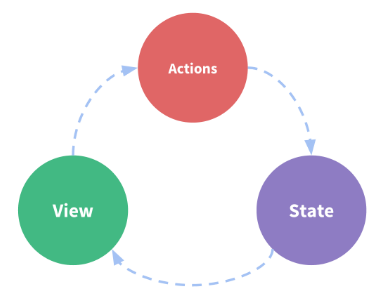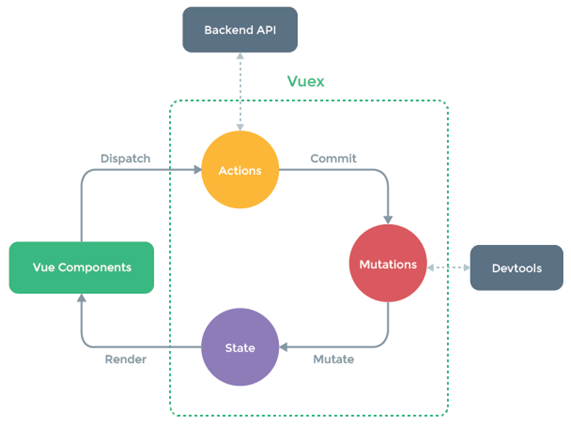一、内容回顾
1、webpack(前端中工作,项目上线之前对整个前端项目优化)
- entry:整个项目的程序入口(main.js或index.js);
- output:输出的出口;
- loader:加载器,对es6代码的解析,babel-loader(官网:https://www.babeljs.cn/)是浏览器支持es6, css-loader解析css文件,style-loader 将css代码添加一个style标签插入header标签中,url-loader等等;
- plugins:有很多,比如html-webpack-plugin,丑陋等等;
二、vue项目中常见问题
我们已经学过如何使用脚手架创建一个vue项目,接下来我们介绍一下vue项目中的常见问题。
1、使用vue-cli脚手架和webpack模板生成一个项目(以项目名为luffy-project为例),步骤如下:
vue init webpack luffy-project // 创建项目(使用单页面应用就安装vue-router,其他选no) cd luffy-project // 进入项目所在目录 npm run dev // 启动项目
2、警告:property or methods "xxx" not defined
出现这个的警告信息,一般是因为你在template中使用了某些数据属性或者方法,但js中没有定义。
3、错误:module not found
出现这个信息表示模块找不到,一般我们使用的模块有两种,一种是npm社区下载的模块(如vue),使用时直接导入(如import Vue from 'vue')即可,这种一般不会出错;另一种是我们自己写的模块,错误往往容易出现在这里,不是名字写错,就是路径不对。
注意:还有就是出现了不是自己写的某个模块出现错误,这时可以尝试把node_modules文件夹删除,再使用下面命令下载项目依赖的包:
npm install // 下载项目依赖的包,生成node_modules文件夹
三、axios
axios相当于jquery的ajax,官网:https://www.kancloud.cn/yunye/axios/234845
将axios挂载到vue的原型上,那么在各个组件中都能使用,因为面向对象(继承),如下:
Axios 是一个基于 promise(es6的语法,参考网址:http://es6.ruanyifeng.com/#docs/promise) 的 HTTP 库,可以用在浏览器和 node.js 中。
// 下载到项目中
npm install axios -S
// 使用方式如下:
// 执行GET请求:
// 为给定 ID 的 user 创建请求 axios.get('/user?ID=12345') .then(function (response) { console.log(response); }) .catch(function (error) { console.log(error); }); // 可选地,上面的请求可以这样做 axios.get('/user', { params: { ID: 12345 } }) .then(function (response) { console.log(response); }) .catch(function (error) { console.log(error); });
// 执行post请求
axios.post('/user', { firstName: 'Fred', lastName: 'Flintstone' }) .then(function (response) { console.log(response); }) .catch(function (error) { console.log(error); });
1、在项目中引用
因为很多模块都要用axios(与后端交互的一项技术),所以我们可以将axios挂载在Vue的原型上,这样,因为面向对象的继承特点,各个子组件都可以使用。挂载方式如下:
// main.js中 import Axios from 'axios' // npm下载的直接引入axios Vue.prototype.$https = Axios // 将axios对象挂载到Vue原型上
注意:一定不要使用Vue.use(),基于Vue的才需要Vue.use(),axios是一个基于es6的知识点,与vue没有关系,不依赖vue,只是vue开发者不想使用jquery库,所以使用axios向后台发请求。
我们可以指定将被用在各个请求的配置默认值,全局的axios默认值有如下几个:
axios.defaults.baseURL = 'https://api.example.com'; axios.defaults.headers.common['Authorization'] = AUTH_TOKEN; // Axios默认发送数据格式是json,要想发送其他格式要设置请求头content_type,如下 axios.defaults.headers.post['Content-Type'] = 'application/x-www.form-urlencoded';
2、项目示例 - 路飞学城官网的免费课程组件相关代码
// main.js import Vue from 'vue' import App from './App' import router from './router' import Axios from 'axios' Vue.prototype.$https = Axios; // 设置公共的url Axios.defaults.baseURL = 'https://www.luffycity.com/api/v1/'; Vue.config.productionTip = false; /* eslint-disable no-new */ new Vue({ el: '#app', router, components: { App }, template: '<App/>' })
// course.vue <template> <div> <div class="categoryList"> <span @click="clickHandler(index, item.id)" :class="{active:index===currentIndex}" v-for="(item,index) in categoryList" :key="item.id"> {{ item.name }} </span> </div> <div class="course"> <ul> <li v-for="(course) in courseList" :key="course.id"> <h3>{{ course.name }}</h3> </li> </ul> </div> </div> </template> <script> export default { name:'Course', data(){ return { categoryList:[], // 分类列表 currentIndex:0, courseList:[], // 课程列表 categoryId:0 // 默认全部课程id } }, methods:{ // 先在methods中声明函数-获取课程分类列表的函数 getCategoryList(){ this.$https.get('course_sub/category/list/') .then((res) => { console.log(res); let data = res.data; if (data.error_no === 0){ this.categoryList = data.data; let obj = { id:0, name:'全部', category:0 }; this.categoryList.unshift(obj) } }) .catch((err) => { console.log(err); }) }, // 获取课程列表 getCourseList(){ this.$https.get(`courses/?sub_category=${this.categoryId}`) .then((res)=>{ var data = res.data; this.courseList = data.data; }) .catch((err)=>{ console.log(err) }) }, clickHandler(index, categoryId){ this.currentIndex = index; // 分类列表点击对应分类变色 this.categoryId = categoryId; this.getCourseList(); // 发送请求 } }, created(){ // 组件创建完成调用函数-使用axios向接口请求课程列表数据 this.getCategoryList() } } </script> <style scoped> .active{ color: red; } </style>
四、vuex
单向数据流概念的简单表示,如下图:

vuex(相当于一个store)有五大将:state、mutations、actions、getters、modules,前三个重要。
各个组件可以通过computed监听vuex中的state中的数据属性,修改state中属性的唯一方法是提交mutations(同步)中的方法,actions中的方法都是异步的。
1、将vuex下载到项目中:
>>> npm install vuex -S
2、组件使用store中的值:
1)使用Vuex的Store方法创建一个store实例对象
import Vuex from 'vuex' Vue.use(Vuex); // 模块化开发要Vue.use() const store = new Vuex.Store({ state:{ num: 1 }, mutations:{ // 同步方法 }, actions:{ // 异步方法 } })
2)将store挂载到Vue实例下
new Vue({ el: '#app', router, store, // store实例挂载到Vue实例,各个组件都能通过this.$store使用 components: { App }, template: '<App/>' })
3)在各组件中通过computed使用store的state中定义的数据属性
// Home组件中使用 <template> <div> <h1>我是首页{{ myNum }}</h1> <Son></Son> </div> </template> <script> import Son from './Son' export default { name: 'Home', components:{Son}, computed:{ myNum:function () { return this.$store.state.num; } } } </script> <style scoped></style>
// Son组件(是Home组件的子组件)中使用 <template> <div> <h1>我是Son组件的{{ mySonNum }}</h1> </div> </template> <script> export default { name: 'Son', computed:{ mySonNum:function () { return this.$store.state.num; } } } </script> <style scoped></style>
3、组件修改store中的值
1)创建store实例对象,并挂在store到Vue实例
import Vuex from 'vuex' Vue.use(Vuex); // 模块化开发要Vue.use() const store = new Vuex.Store({ state:{ num: 1 }, // mutations中定义同步方法,默认传递一个state mutations:{ setMutaNum(state, val){ state.num += val; }, setMutaAsyncNum(state, val){ state.num += val; } }, // actions中定义异步方法 actions:{ // 方法都默认传递一个context,就是store setActionNum(context, val){ context.commit('setMutaNum', val); }, setActionAsyncNum(context, val){ setTimeout(()=>{ context.commit('setMutaAsyncNum', val) },1000) } } }) new Vue({ el: '#app', router, store, components: { App }, template: '<App/>' })
2)在Son组件中触发actions方法修改store中的值(同步和异步)
<template>
<div>
<h1>我是Son组件的{{ mySonNum }}</h1>
<button @click="addNum">同步修改</button>
<button @click="addAsyncNum">异步修改</button>
</div>
</template>
<script>
export default {
name: 'Son',
methods:{
addNum(){
// 不要直接修改state中的状态,要通过commit方法提交
// commit()第一个参数是触发store的mutations中的方法名
// 第二个参数给触发的方法传递的值
this.$store.dispatch('setActionNum', 2)
},
addAsyncNum(){
this.$store.dispatch('setActionAsyncNum', 3)
}
},
computed:{
mySonNum:function () {
return this.$store.state.num;
}
}
}
</script>
<style scoped></style>
4、vuex的actions中使用axios请求数据

1)课程详情组件CourseDetail.vue代码如下:
<template>
<div>
<div class="">
<h2>我是课程详情组件</h2>
<p v-for="value in courseDesc">{{ value }}</p>
</div>
</div>
</template>
<script>
export default {
name:'CourseDetail',
created(){
// https://www.luffycity.com/api/v1/course/3
console.log(this.$route.params.courseid);
// 组件创建则向触发发送axios请求
this.$store.dispatch('course_top', this.$route.params.courseid)
},
computed:{
// 获取store中的数据,数据是由axios请求而来的
courseDesc(){
return this.$store.state.courseDesc
}
}
}
</script>
<style scoped>
.active{
color: red;
}
</style>
2)创建store实例对象,代码如下:
import Vuex from 'vuex' Vue.use(Vuex); const store = new Vuex.Store({ state:{ num: 1, courseDesc:null }, mutations:{ course_top(state, data){ state.courseDesc = data } }, actions:{ course_top(context, courseId){ // 异步:发送axios请求 Axios.get(`course/${courseId}/top/`) .then((res)=>{ let data = res.data.data; context.commit('course_top', data) }) .catch((err)=>{ console.log(err) }) } } })
五、补充知识点
1、v-for一定要加key
演示如下代码(分别在有key和没有key的情况下点击按钮):

<!DOCTYPE html>
<html lang="en">
<head>
<meta charset="UTF-8">
<title>v-for中的key</title>
<style>
.userList {
border: 1px solid red;
margin: 20px 0;
padding: 10px 10px;
}
</style>
</head>
<body>
<div id="app"></div>
<script type="text/javascript" src="vue.js"></script>
<script type="text/javascript" src="lodash.js"></script>
<script type="text/javascript">
Vue.component('my-com', {
template: `
<div class = 'userList'>
<div class = 'content'>
<h3>{{obj.name}}</h3>
<p>{{obj.content}}</p>
</div>
<div class="control">
<input placeholder="请输入你的名字" />
</div>
</div>
`,
props: {
obj: Object
}
});
var App = {
data() {
return {
datas: [
{id: 1, name: '张三', content: '我是张三'},
{id: 2, name: '李四', content: '我是李四'},
{id: 3, name: '王五', content: '我是王五'},
]
}
},
template: `
<div>
<button @click = 'shuffle1'>shuffle</button>
<my-com v-for = '(obj,index) in datas' :obj = 'obj' :key = 'obj.id'></my-com>
</div>
`,
methods: {
shuffle1() {
console.log(_.shuffle());
this.datas = _.shuffle(this.datas);
}
}
}
new Vue({
el: '#app',
data: {},
components: {
App
},
template: `<App />`
});
</script>
</body>
</html>
2、js中数组的splice方法
var arr = ['alex', 'wusir', 'egon', 'sylar']
// arr.splice(开始位置索引, 删除个数, 插入元素)
arr.splice(1, 2) // 索引从1开始,删除2个,返回删除元素列表,即['wusir', 'egon'] // 原数组arr为 ['alex', 'sylar']
arr.splice(0, 0, '张三', '李四') // 索引从0开始,删除0个元素,即不删除任何元素,返回[]数组, // arr变为['张三', '李四', 'alex', 'sylar']
总结:可以做增删改操作。
3、Vue模块化开发中,如何注册全局组件
假设已经定义了一个组件Header.vue并抛出,在全局的main.js下按如下方式写:
import Header from '@/components/Header/Header'
Vue.component(Header.name, Header);
这样,Header组件就是全局组件了,在任意组件中直接使用即可。
